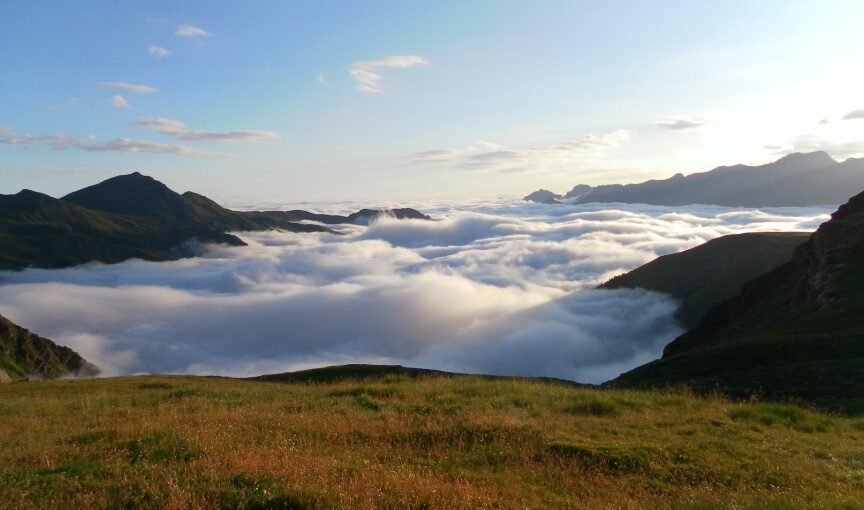Trekking in the High Pyrenees, France
Harry Cox, September 28, 2014

In July two friends and I set off to tackle a two and half week section of the Pyrenean Haute Route (HRP). This route starts on the Atlantic coast, in the town of Hendaye, and makes a complete traverse of the range, eventualy arriving on the shores of the Mediterranean, at Banyuls-sur-Mer.
Unlike its lower level equivalents on the French and Spanish side of the border, the GR10 and GR11 respectively, the HRP sticks doggedly to the main ridge of the Pyrenees. This route undoubtedly increases the challenge, as there are few places to replenish supplies and trekkers are often several days walk from the nearest settlement, but the flip-side of this is the chance to experience the remoteness and vastness of a truly inspiring mountain landscape. Moreover whilst the trail is often well marked there are parts where good route finding skills are necessary and navigation by compass is essential. Ton Joosten’s guide to the Pyrenean Haute Route, published by Cicerone Press, proved to be of invaluable assistance with regard to navigation as well as providing many useful details and descriptions of the trail as a whole.
The route provides enormous variety but a typical day on the HRP will often involve over 1000m of ascent and descent over mountain terrain which is often difficult and at times dangerous. We decided to tackle the section from Lescun to Luchon, a stretch which would see us repeatedly cross the border between France and Spain and enjoy some of the most dramatic scenery the Pyrenees has to offer, particularly in the form of the iconic Pic du Midi d’Ossau and Vignemale mountains.
Accommodation
In spite of the remoteness of the HRP many of the stages begin and end in specialist mountain refuges which provide accommodation and meals to passing trekkers. These shelters vary in size but are kept very clean and are run in an impressively professional manner. As a result of their quality and remoteness these shelters can be expensive but for those looking for a cheaper alternative it is often possible to bivouac near the shelters, or in other parts of the mountains. It should be noted though that rules for bivouacking do vary, particularly in national park areas.
Alternative Routes
One of the great benefits of trekking in the Pyrenees is the flexibility that is provided by the three long distance trails, the HRP, GR10 and GR11, which traverse the range. This enables trekkers to tailor their entry and exit points to the routes as well as providing ample opportunity for those wishing to summit several of the major Pyrenean summits, many of which require little or no technical expertise. This flexibility can be particularly useful when weather conditions deteriorate.
Getting there responsibly
Depending on the section of the route that you have chosen to tackle there are several major towns such as Bayonne, Pau, Tarbes, Foix, Perpignan and Toulouse from which the mountains can be accessed. See greentraveller.co.uk for information on trains to each of these centers.
Further information
- Although each year varies, snow can linger in the high passes of the route until late June, sometimes not melting at all. Consequently crampons and an ice axe may be needed for a couple of the highest passes.
- If camping carefully consider the implications of having to carry up to a weeks worth of food as well as the temperature when camping up above 2,000m – it can get quite cold even in summer!
- More detailed topographic maps can be purchased from Stanfords.